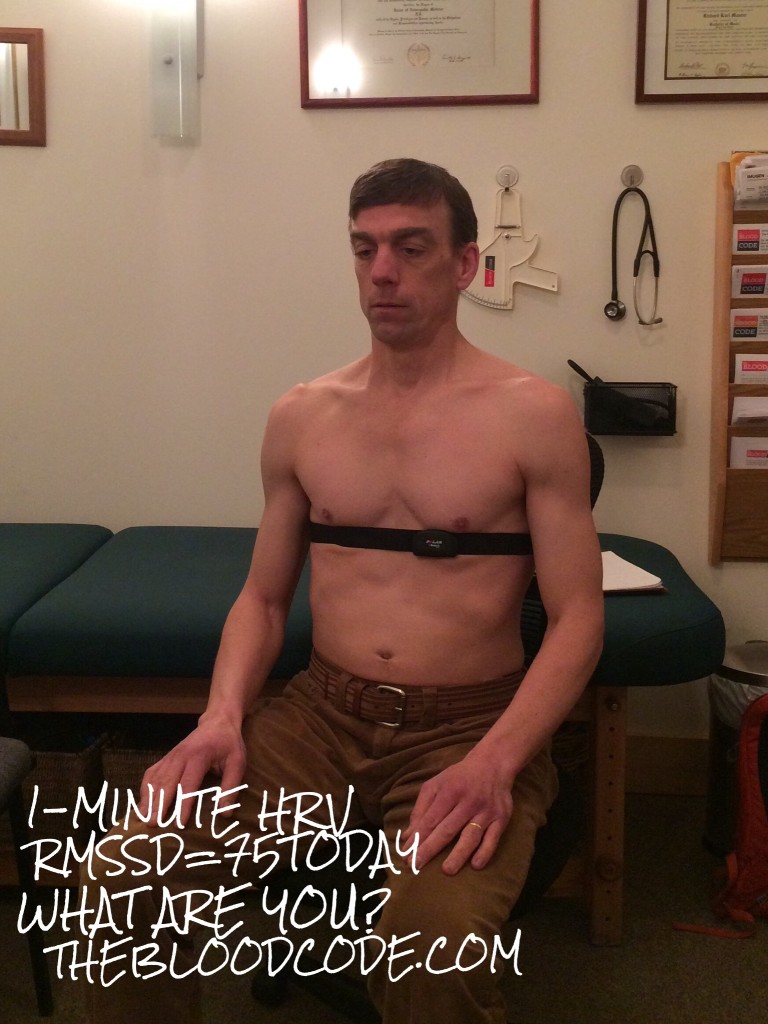Dr. Richard Maurer, ND
@drrichardmauer
Every client I see, I explain about why I am strapping electronics to their chest, “This is a heart rate monitor. I’ll be able to calculate a number called heart rate variability while you breathe deeply for a couple minutes.” It must sound simple enough because everyone agrees. And why not? After all, everyone I see has been through the Blood Code workup and this HRV has no pain, no fasting, and no strenuous workout like VO2 assessment – Just breathe. How can a meaningful health metric come from such a non-invasive measurement? And what is heart rate variability (HRV) anyway?
What is HRV?
For the mathematician in you, let me answer it this way—HRV analysis is based upon a calculation called the RMSSD (root-mean square differences of successive R-R intervals) and indicates, in yet more science talk, the integrity of vagus nerve-mediated autonomic control of the heart. If you are interested, a fine 2014 article in the journal Circulation elaborates on the science and use of HRV testing.1
Let me unpack the above jargon. RMSSD marks the ability for your body, your heart muscle in this case, to respond to the alternation of stress and relaxation, in this case with alternating inhalation and exhalation. The vagal nerve is part of your parasympathetic nervous system, the flip side of your sympathetic nervous system. It’s Yin and Yang—Stress in your life (Yang) demands an adequate recovery (Yin). Many type A folks are pretty good at going for runs, rides, workouts, classes—activities that drive the fight-or-flight type sympathetic nervous system. Whereas, rest, meditation, recovery meals and conscious breathing exercises offer the “rest and digest” parasympathetic nervous system a oft-needed chance to strengthen.
Therein lies the test. At a neurologically functional level, are you balanced? If your life stress (anxiety, exercise, daily demands) does not have adequate rest and recovery (replenishing meals and nutrition, adequate sleep, recovery time), your heart rate variability reduces to a lower value. If you are an athlete, your performance times will drop at this point. But those of us with longevity and wellness goals, less variability predicts cardiovascular disease mortality not only in people with current coronary artery disease or chronic heart failure but also in apparently healthy populations.2,3,4

In my practice, I measure RMSSD during a couple 1-minute seated deep breathing exercises. I have generalized RMSSD ranges (in milliseconds – ms) to the following ranges:
- Extremely fit adult individuals are >75
- 50-75 indicates a level of protective cardio fitness
- 25-50 is normal for adults
- 10-25 is problematic
- <10 is alarming
There is strikingly little data on uniform ranges in a population. In one study from India comparing three adult groups; healthy volunteers, people with hypertension and regular smokers, displayed that RMSSD dropped respectively. Controls had an RMSSD of about 37ms while those with hypertension and smokers were about 27ms and 22ms respectively.5
How do you get to the protective higher range for your RMSSD? This is where I take a wide angle view of health and wellness. If you need to see your heart rate variability improve, address the balance between stimulation and recovery. Over-stimulations could result from too much caffeine, un-checked emotional stress or maybe even working out too much. Under-recovery might be a lack of sleep quantity, inadequate breathing, or poor nutrition. You can also physically train in a way that allows your body to practice heart rate recovery. I have written before about the benefits of high intensity interval training and I myself have drastically modified my workouts to be less steady-state aerobic activity and much more interval style workouts, whether outdoors or in a gym.
Find a practitioner that uses HRV testing, or hack the data yourself with a good heart rate monitor (HRM) with an HRV app. Personally, I have successfully worked with both Elite HRV and HRV+ with a Polar H7 wireless monitor. Calculating standard deviation always intimidated me in high school math, but the meaning of RMSSD is a welcome nudge toward our path toward a long and healthy life.
 Dr. Richard Maurer is a licensed naturopathic physician who, after practicing in a primary care setting for twenty years, now provides a unique perspective on metabolic health and recovery. Dr. Maurer puts you in the driver’s seat of your health and wellness, helping you decode blood test results to find the diet and fitness habits that reverse and prevent metabolic conditions, such as pre and type 2 diabetes, weight gain and hypothyroid problems. His recent book, The Blood Code: Unlock the secrets of your metabolism [2014], provides the tools to understand and act on key blood tests and skin fold measurements to define your personalized diet, fitness and nutritional needs to recover health and vitality—disease reversal is only the beginning.
Dr. Richard Maurer is a licensed naturopathic physician who, after practicing in a primary care setting for twenty years, now provides a unique perspective on metabolic health and recovery. Dr. Maurer puts you in the driver’s seat of your health and wellness, helping you decode blood test results to find the diet and fitness habits that reverse and prevent metabolic conditions, such as pre and type 2 diabetes, weight gain and hypothyroid problems. His recent book, The Blood Code: Unlock the secrets of your metabolism [2014], provides the tools to understand and act on key blood tests and skin fold measurements to define your personalized diet, fitness and nutritional needs to recover health and vitality—disease reversal is only the beginning.
His personal and familial trend toward type 2 diabetes motivates him to empower people to recover their metabolic “sweet spot” through proven self-guided diet, nutritional, and fitness habits.
Dr. Maurer is the past president of the Maine Association of Naturopathic Doctors and regularly presents at health and medical conferences such as Weston Price Foundation, American Association of Naturopathic Physicians and the popular PaleoF(x). He lives in Maine with his wife Alexandra where they have raised three children.
References:
- Porier, P. Exercise, Heart Rate Variability, and Longevity: The Cocoon Mystery? Circulation. 2014;129:2085-2087 [http://circ.ahajournals.org/content/129/21/2085.full]
- Kleiger RE, et al. Heart rate variability: measurement and clinical utility. Ann Noninvasive Electrocardiol.2005;10:88–101.
- Dekker JM, et al. Low heart rate variability in a 2-minute rhythm strip predicts risk of coronary heart disease and mortality from several causes: the ARIC Study–Atherosclerosis Risk in Communities. Circulation.2000;102:1239–1244.
- Galinier M, et al. Depressed low frequency power of heart rate variability as an independent predictor of sudden death in chronic heart failure. Eur Heart J. 2000;21:475–482.
- Urooj, M. et al. Reference ranges for time domain parameters of heart rate variability in Indian population and validation in hypertensive subjects and smokers. International Journal of Pharmacy and Pharmaceutical Sciences. Vol 3, Issue 1, 2011.

















